Fishing in Early Medieval Times

The consumption of fish was an important part of life in the early medieval period and therefore the catching, preparation, storage 1 and cooking 2 played an equally significant role in everyday life. Although in 730 AD, according to Bede, Bishop Winfrid of Colchester apparently:
'...found so much misery from hunger, he taught the people to get food by fishing. For, although there was plenty of fish in the seas and rivers, the people had no idea about fishing, and caught only eels. So the Bishop's men got together eel nets from all sides and threw them into the sea. By God's help they caught three hundred fish, of all different kinds.'
Much of the evidence for the consumption of fish has come from both toilet pits and soil excavations of archæological sites from the period. There is also a wealth of evidence, through manuscripts, carvings and 'fishing' artefacts, to establish the fact that fishing took place. It is also noted that fish and fishing played an important part by the need to make numerous references to fisheries in the Domesday Book and at least one fish-processing plant . 3 It is by making use of these two major areas of evidence that we are able to piece together exactly what varieties of fish were eaten and how they may have been caught.
It must be remembered that the rivers and seas of today are heavily polluted and the effect this has upon the quality and quantity of species of fish is paramount when investigating fish catching and eating of years gone by. It is only recently that the River Medway has become an almost open sewer with factories pumping out toxic wastes with little or no control from Government or local water authorities. Prior to 1907 there is evidence to show that the River Medway supported a thriving community of fishermen. P.S. Kemsey, MBE, wrote:
'The Medway in our days [1895-1907] was a clean river and it carried quite an assortment of fish. Each Spring at high tide, two fishing boats would lie upon the Halling side of the river and for a month would remain there catching Smelts along with Dabs and other fish. The Smelts were packed and taken to Halling Station for dispatch to London................We watched as the men emptied their net, which was towed through the water by two men rowing and two men walking along the shore with the net end rope.
In summer porpoises frequently swam up the Medway as far as Allington [end of tidal flow]......... Sunday afternoon was shrimp time for the village........Gravesend was noted for its shrimps in our time, and there were also shrimp boats at Strood.'4
In summer porpoises frequently swam up the Medway as far as Allington [end of tidal flow]......... Sunday afternoon was shrimp time for the village........Gravesend was noted for its shrimps in our time, and there were also shrimp boats at Strood.'4
It was also quite common to see, until quite recently, a much wider acceptance of the eating of a much wider range of freshwater fish: roach, bleak, perch, pike, carp, gudgeon, etc.One can imagine the clean, fresh, free-flowing rivers of Saxon England teaming with an abundance of aquatic life. A natural larder that was spread throughout the whole of the country that supplied fresh sustenance all through the year. 5
The seas, as today, acted as a rich source of food of both fish and shellfish. Also noted is the fishing and catching of porpoises and whales as well as the more common species that we fish for today.6
Fish Catching Methods
Hook & Line
The use of hook and line to catch great quantity of fish is an unproductive method to use. However, this is a method that was used in pre-conquest times for many of the same reasons as it is used today: it is less demanding upon materials. Today the use of rod, reel, line and hook is mainly employed by the sporting fraternity whilst the early medieval period the use of hook and line was part of ones' livelihood. Although there is some evidence to suggest that reels were employed in China c. 3000BC they were not in common use in this country until late 13th-early 14th century.
To angle is to fish with rod and hook and, in fact, the use of a pole or rod was not introduced into this county until the 13th century. The first recorded account of an angler was of an abbess fishing for carp and by 1496 the art of angling had produced its first book written in English; Treatise of Fysshynge with an Angle by Dame Juliana Berners. There is, however,
Long lining
a Byzantium illustration depicting what appears to be a fishing rod or pole. It is, of course, possible that the use of lengths of wood to aid in the practice of fishing actually took place, but this has not been documented as being a common exercise.
Of the many hooks that have been discovered from the period nearly all have been 2/o or above. This might seem to suggest that only the larger species of fish were sought after although smaller hooks would be more difficult to unearth and would also be more likely to disintegrate during the passage of time. All of the hooks I have seen show a simple round bend design with either an open eye or a spade end and have been made from iron. One such hook, found at West Hythe in Kent and dated to come from the 9th or 10th century, can be seen at the British Museum. The hook itself is approximately four inches long, somewhere between 8/o to 10/o in size, spade ended and is made from iron. The actual design differs little from that of hooks that were used by the early Romans or those used by Sir Izaak Walton. The barb seems oversized by today's standards but this may be due to the need to keep the fish secure on the line whilst 'long-lining' or because it is, as I discovered, by far the most difficult part of producing a hook.
The line itself would have to be strong, not too effected by water and easily obtainable. By far the most common material that would have all the necessary qualities would be that of nettle-hemp. The nettles would be gathered in the Spring and early Summer 7, the leaves stripped off them and the stems immersed in water for several hours. After removing from the water they would be pulped so that the individual strands would peel away producing long, thin fibres. These fibres would then be spun in the same way as flax or wool. The resulting 'yarn' would then be used in the making of fishing line, nets and bow strings. 8 The two main methods employed with hook and line were simple 9 hand lining for single fish and long-lining. The trace used for simple fishing is basically an iron forged hook, nettle-hemp line and stone weight for a sinker. This method would be useful for catching the larger fish in enclosed waters, rivers and from the sea shore.
Long-lining involves, as the name suggests, a long line to which several hooks are attached to by short snoods. The line could be fixed to solid points at low tide and baited at the return of the following low tide the fisherman would then go and collect the caught fish. This method gave the fisherman the opportunity to set out more than one long-line, in different locations and without too much concern for weather conditions. Long-lining could also be carried out from a small fishing boat: the line would be either floated upon the surface for top-feeding fish or sunk to the bottom for bottom-feeding fish. Whichever system was in use one end would have probably been secured to the boat to safeguard the line and hooks from being lost.
Fishing with Nets
The catching of fish on a larger scale at sea involved the use of fishing nets and from evidence of finds at Birka and Ribe these too were made from nettle-hemp. It would also appear that the nets that were made were not exclusively for the use of fishermen; they would be used for trapping and be a convenient method as bags for storage and carriage.
The construction of fishing nets is similar to that of recent years and it is only necessary to master the use of only two knots: the clove-hitch and the sheet-bend.
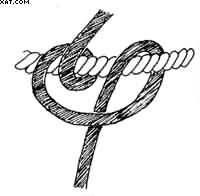
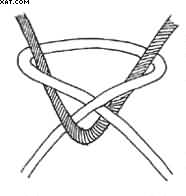
First of all a heavier duty line is positioned at a convenient working height and running the estimated length of the intended net.
A long quantity of nettle-hemp is then tied to the main line using the clove-hitch knot; these need to be equally spaced along the main line. After the length of the main line has been completed it is then that the hemp is tied together, using the sheet-bend, to form the mesh. The most difficult and important part of the operation is the ability to make sure that the mesh is kept to the same dimensions: fingers or a piece of scrap wood may be used as a rough guide. To help hold the nettle-hemp a netting needle may be used. The netting needle can be made out of wood, bone or antler.
Stone weights have been found that have been attributed as net sinkers. These weights have a hole or holes bored into them and help, with the aid of buoyant floats, keep the net vertical in the water and fished as a gill or seine net. An alternative style of net sinker has been found at Hedeby in Northern Germany. Rather than drill a hole through a stone, a hoop of willow or hazel is made around the stone which is fairly flat to start with, then across and either side of the stone, some bark crosses are sewn with fine bark strips to the hoop, pinning the stone in between. The hoop left sufficient room between the stone and the hoop itself.
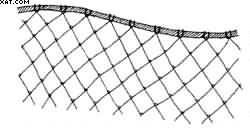
Long-netting could also take place in similar locations to that of the on-shore long-liner. The net would be angled so that the incoming tide would wash over it and then, on its way out, fish would become entrapped. A variation upon this is to make a tide pool out of rocks, which allows the tide to flood it and bring in fish too, but as the tide runs back out to sea, the pool drains through the stones trapping the fish behind the rock wall.
Nets would have also been used to net off sections of rivers or even complete rivers to trap migratory fish such as salmon, trout and sea trout. They may also have been used to section off breeding areas as the Romans had done a few centuries earlier.
Haaf-netting (from the Norse 'haf', the open sea) was a form of net fishing practised in areas like the Solway Firth mudflats to catch salmon. The nets used are cumbersome affairs - 16 feet (5 meters) of meshed twine slung over a 14 foot pole. The fishermen would form a line and walk up to their chests against the tide in the channel. The haafer holds the net against the water with his left hand and grips the beam with his right. He pulls six meshes with his thumb to make a bag, and when a salmon enters he presses down on a special rung. The haaf floats to the top; the netsman turns his back to the tide, kills the fish with his 'mell', or mallet, and flings it into a special compartment - while concentrating on not being swept away by the strong tidal flow. 10
Fish Traps
Although little has been recovered in the way of wicker fish traps, they are referred to in Anglo-Saxon texts 11 and from illustrations from the period. The traps would have mainly been used in flowing rivers and tidal estuaries to catch all manner of fish including eel, salmon, trout, dabs, flounders, etc. They would have been about 5 feet long and would have consisted of two chambers: a large opening funnelling into the main basket.

A typical cross-section of a fish trap.
Along the mudflats on the South Essex coast an aerial survey identified a massive complex of wooden fish-traps, comprising up to 13,000 timber posts, located ½ a mile out to sea. A more detailed investigation carried out by boat has revealed a dozen lines of timber - some of them more than half a mile long- in the Blackwater estuary, 15 miles south of Colchester, dating from the 7th to 10th centuries AD. The timbers were the uprights of wattle fences, the complex containing up to 100,000 square feet or 30,500 square metres of fencing, some of which still survives.
The fences - laid out in a series of V-shapes - were used to funnel the outgoing tide, and its fish, into nets at the apexes. They would have yielded several hundred thousand fish per year: far too many to supply a single community, suggesting that the trapping was carried out for commercial purposes. The fish would have been salted, dried and, presumably, sold to communities in south-east England. It is not known who maintained these traps but, just seven miles away is Bradwell-on-Sea, where one of Englands earliest monasteries stands, founded in 654 AD. Across the Thames estuary from the Blackwater lies the estuary of the River Medway with similar terrain features. Along the Medway estuary, although no extensive finds such has been found on the Blackwater, references to 'fish factories' are included in the Domesday Book. One wonders! 12
It is likely that the trap was flat bottomed to allow it to lie on the river or sea bed without rolling with the current or tide. For eels it would need to be baited with a dead fish, this would attract the carnivorous eel into the funnel and once inside, they would find it difficult to escape. Single chambered traps may also have been used by the early medieval fisherman; these would have been something akin to the salmon putchers used earlier this century in Scotland and on the Severn River. The main advantage of these traps was that smaller fish could be caught, there was little danger of the fish swimming away from them as in the case with a net and they were relatively easy to maintain.
The traps themselves would be made from willow 'withies' that had been cultivated for at least three years. Today there are withy beds in the Southwest that produce willow withies in white, buff and brown. White withies are produced by stripping the bark away, the buff has been boiled with its bark on and then the bark then removed and the browns are the withies complete with bark. In the early medieval period the majority of the basket work was functional and there was no need to add extra work to the making of fish traps and baskets: brown withies would have been the most common. To weave the withies they would need to be soaked so as to make them pliable, they would need to be left to soak overnight to enable the surface water to penetrate to the pith of each withy.
Fish Spears
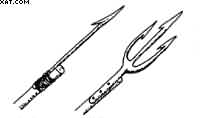
A number of fishing spears has been identified from the period and these have taken a number of different styles.
The type of fishing that would have taken place with the use of spears would have involved the larger top-feeding fish and mammals. The larger and more robust spear would have been used to hunt for whale, porpoise, seal and sturgeon whereas the finer spear would have been used for fish such as salmon, mullet, eel, etc.
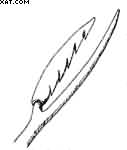
A typical eel spear. Notice the many-barbed side to perfect a grip upon those slimy little beasties.
Eels were a favoured fish of the period and these were caught by spear too. During the winter months the eel buries itself into the mud together with other eels. By using a spear one can poke around into the muddy bottoms of river or estuary until an 'eel nest' is located; many eels can be caught in this manner.
Lures
Today much is made in the way of lures to attract fish and these include pirks for deep-sea fishing, flies for trout, salmon and grayling, plugs and spinners for pike, salmon, bass, cod and flounders. There has been little in the way of recovered artefacts to show that the people of the 10th and 11th century made much use of such items. There is, however, one example of a gold fishing lure; similar in design to a Devonshire Minnow, that is dated to the period. This lure, now housed in a Cumbrian museum, is thought to have been used to fish for the elusive char that is renown in the Lake District.
© 1993 D. Green & Regia Anglorum Illustrations © 1993 Colin Levick
